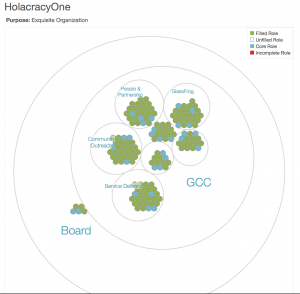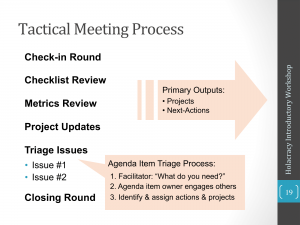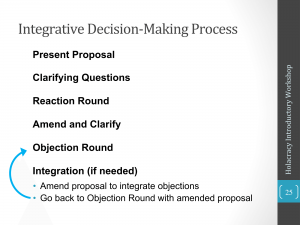
I went to a workshop last week to find out about Holacracy. Everyone I’ve since spoken to about it had never heard of it, but were intrigued to find out more.
So what is Holacracy?
Fundamentally, it is a way of structuring an organisation which replicates the way people interact in a city.
In a traditional top down hierarchy, people do jobs which satisfy a particular, usually very fixed job description – they become cogs in a machine. Traditional organisations often face challenges around unnecessary bureaucracy, unclear decision making, political infighting, painful meetings, rigidity, lack of engagement and so on – you may recognise some of these in your organisation.
People often assume that this is the only choice, yet there are alternatives. Holacracy is one of them.
There are a few fundamental principles to understand regarding how Holacracy works:
Organisational Structure
Organisations are structured around the work, not the people. This means that roles are identified and defined that are necessary to make the organisation work. People then ‘energize’ those roles. As an employee, you may energize many roles – the number of which would depend on their complexity.

Each role has an explicitly stated ‘purpose’ – the person filling that role is allowed to do whatever it takes to achieve that purpose – within the law of course! The role description also identifies ‘accountabilities’ – things which the person filling that role is fully expected to achieve. Finally, the role may include a ‘domain’ – something that no other role can encroach upon.
If that all sounds a bit abstract, the idea is analogous with your position in the city. You may wear several hats – you may be a mother, daughter, wife, plumber, volunteer, school governor and a carer. Your purpose when filling each of these roles is different and you are accountable for each role. Your domain is like your car – nobody else can drive it – only you.
The roles are organised into circles which are fully autonomous and people can fill roles in more than one circle. Circles are concentric with smaller circles existing in the larger circles, like Russian Dolls.
Another fundamental principle to understand is that there is a strict split in dealing with governance issues and operational issues – working on the engine of the car is done separately from driving the car.
There are two main types of meeting which are used to resolve internal issues. ‘Governance meetings’ are used to resolve issues relating to the operating system whilst ’tactical meetings’ are used to consider operational issues – when there is a tension between what is going on in the organisation and what could be happening.
The meetings follow a strict process and the agenda is quickly created at the start of the meeting by all participants. In the training workshop, we practised governance and tactical meetings – which was very powerful. One of my main takeaways from the training was the format of the meetings. They were efficient, avoided emotional confrontation and demonstrated an effective way to resolve differences without reverting to consensus. The meeting format is below. However, without having experienced it, it’s difficult to appreciate quite how powerful it is.
How do you get a role?
Each circle has a ‘lead link’ who can allocate a role to a person, for which you are entitled to choose whether you take it on; you could also request a role. I like to think of it as you arrive at the organisation with an empty suitcase and you fill it with roles – which may be substituted over time as you develop and the organisation changes.
How are people remunerated?
This isn’t specified in the Holacracy constitution so its down to the organisation to decide. Suffice to say, the more roles you energize effectively, the more you will be rewarded.
Who tells me how to do my job?
Nobody. You have total autonomy and accountability to energize the role you’ve been allocated.
How do people get fired?
Lead links can remove people from roles, yet if you loose a role, it doesn’t mean that you’ve been sacked. It means you have more capacity to go shopping around the organisation for another role to energize. If you get removed from all your roles, that would be an indication that your time with the organisation is limited!
I think that this arrangement allows more fluidity in what people do within an organisation, reduces the number of roles which are being filled ineffectively, and keeps people on their toes when energizing a particular role. It allows an organisation to be much more responsive to the needs of customers and the market they’re working in.
Holacracy is the operating system of the organisation – the platform. Not everything is defined; so things like how you remunerate, agree strategy, sack people or review performance is down to the individual organisation to decide.
How would an organisation move from hierarchy to Holacracy?
If a CEO wants their organisation to adopt Holacracy, they need to be prepared to relinquish a significant amount of control. They will no longer be the final decision maker on all things related to their organisation, which requires a significant shift in mindset.
To make the transition from hierarchy to Holacracy takes around 6 – 9 months. Small companies can adopt this new system wholesale whereas larger companies usually try it out in a discrete part of the organisation first, but find that it soon spreads as they they get slowed down by the remaining traditional parts of the organisation.
The largest company to transition to Holacracy to date, with 1,500 employees, is Zappos – a US based shoe retailer renowned for it’s ‘Family Values’, excellent customer service and high levels of staff engagement. They were bought by Amazon in 2009. Their transition to Holacracy has been gradual, starting with HR in 2013 and spreading to other parts of the organisation from 2014.
Operating with a foot in both camps – the old and the new must be a cause of immense frustration. The learning curve to adopt the new system is intense and inevitably means that the organisation will go through a dip when they are less productive than they would have been under the old system. As has been the experience in other organisations, some have left as a result. However, the new system has allowed long standing tensions to be addressed and the long term vision is that it will give Zappos increased adaptability in an ever changing marketplace.
Only a handful of companies in the UK are using Holacracy right now (list at the bottom) – this is new stuff – for the early adopters at the moment. Will it become the norm? Only time will tell. It certainly opened my eyes to the alternatives. Are you ready to make the change?
My big takeaways
I could see the meeting structure set out for governance meetings being a really effective way to run meetings in general and resolve disputes in an organisation and could have particular use in a collaboration project.
The openness of the system is very appealing – all roles are available for all in the organisation to see and all responsibilities are explicit.
Strictly splitting governance and operations seems effective in helping you to understand exactly what it is you are in a meeting to discuss and avoids the conversation drifting. It also makes it easier to avoid discussions over things which were none of your business. How many times have you been in meetings where you’ve ended up checking your emails or Twitter whilst the conversation drifted off to something which was of no concern to you?
I love the idea of having a suitcase full of roles which can change over time depending on the needs of the organisation and your own personal development. I believe that people working in organisations which have adopted Holacracy would on average be more engaged with their work.
When you think about what drives motivation – autonomy, purpose and mastery, according to Daniel Pink – you can see how someone working in an organisation practising Holacracy would expect to have high levels of staff motivation and engagement. Although I understand that organisations which transition from hierarchy to Holacracy find that on average 10% of staff leave the organisation because it doesn’t suit them.
I have doubts over whether this system would eliminate siloed thinking because people still occupy particular roles within the organisation and wear particular ‘hats’ when making decisions.
I understand that research is ongoing to establish the facts regarding performance of organisations with and without Holacracy and I await the results of that with interest.
I will be taking some of the things I learnt on the workshop, and adopting them when working on collaboration projects. My biggest take away was the dispute resolution procedure for meetings, which I will be experimenting with some time soon. It has also got me seriously thinking about the structure of our own organisation when we eventually start to grow the business.
If you’re interested in experiencing the training I had, check out Evolving Organisation. Their next training course is on 21 May 2015 in London.
If you’re interested in the idea of a more connected company, there are other methods such as wirearchy, sociocracy or becoming a responsive organisation which are also worth exploring.
Organisations in the UK which have adopted Holacracy:
Evolving Organisation- www.evolvingorganisation.com
Redacap- http://www.redacap.com/?page_id=97
Conscious Capitalism UK chapter – I have heard are using Holacracy
Give What You are Good at- http://www.givewhatyouregoodat.co.uk using it since 2013
Sustainable Frome – using Governance process only




Pingback: A powerful experience of Holacracy in action - report from an introductory workshop : : Evolving Organisation